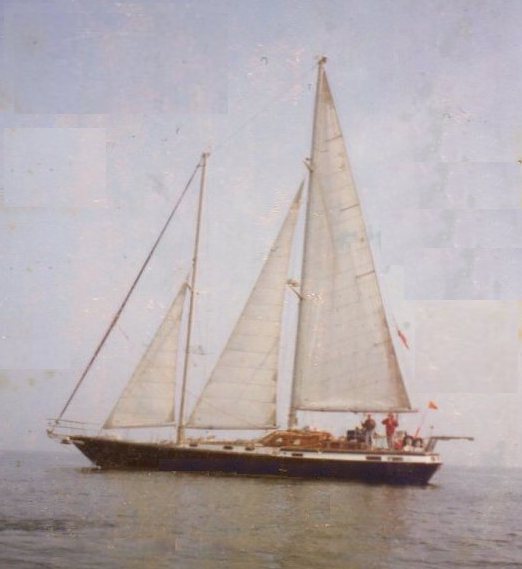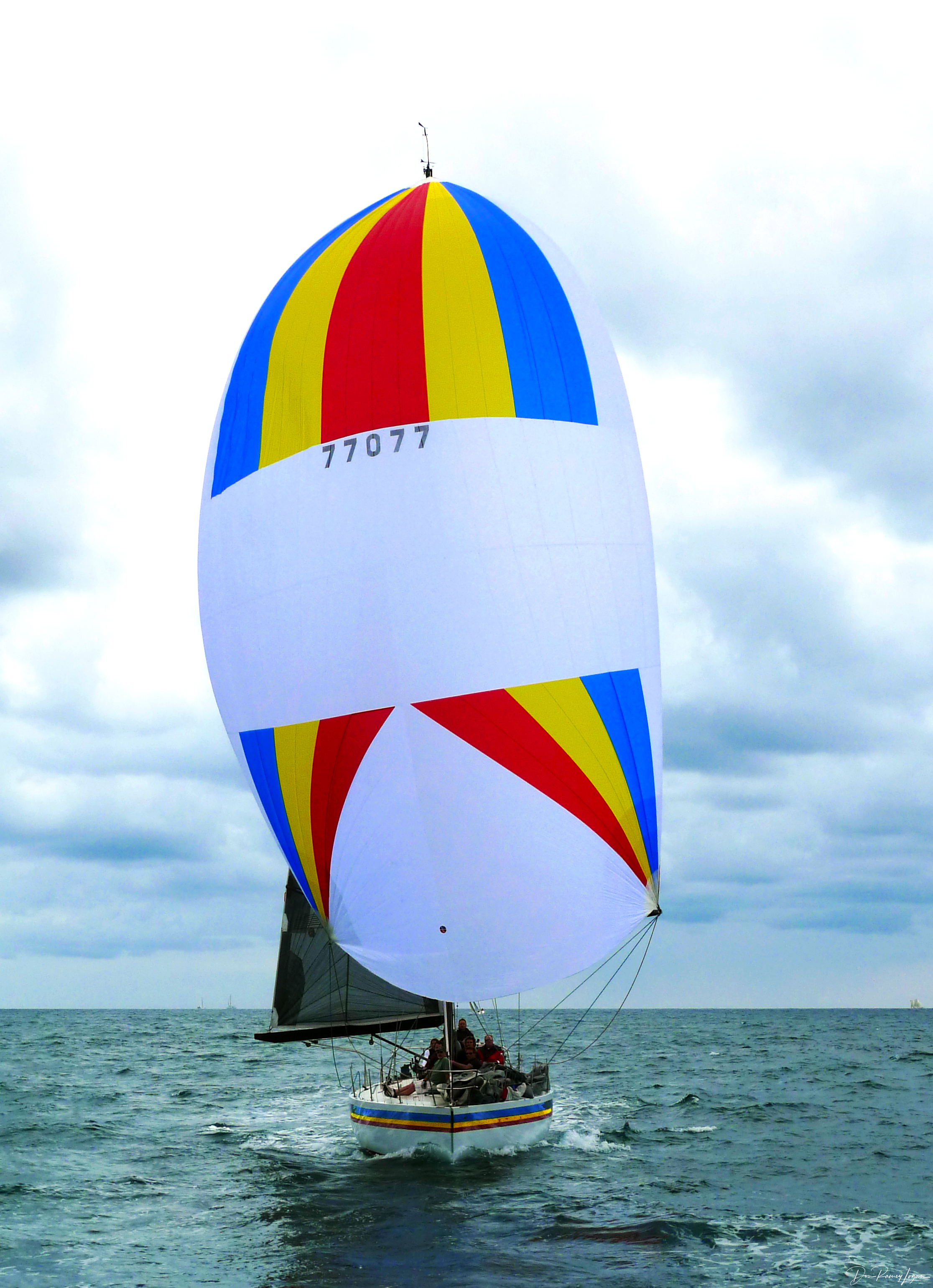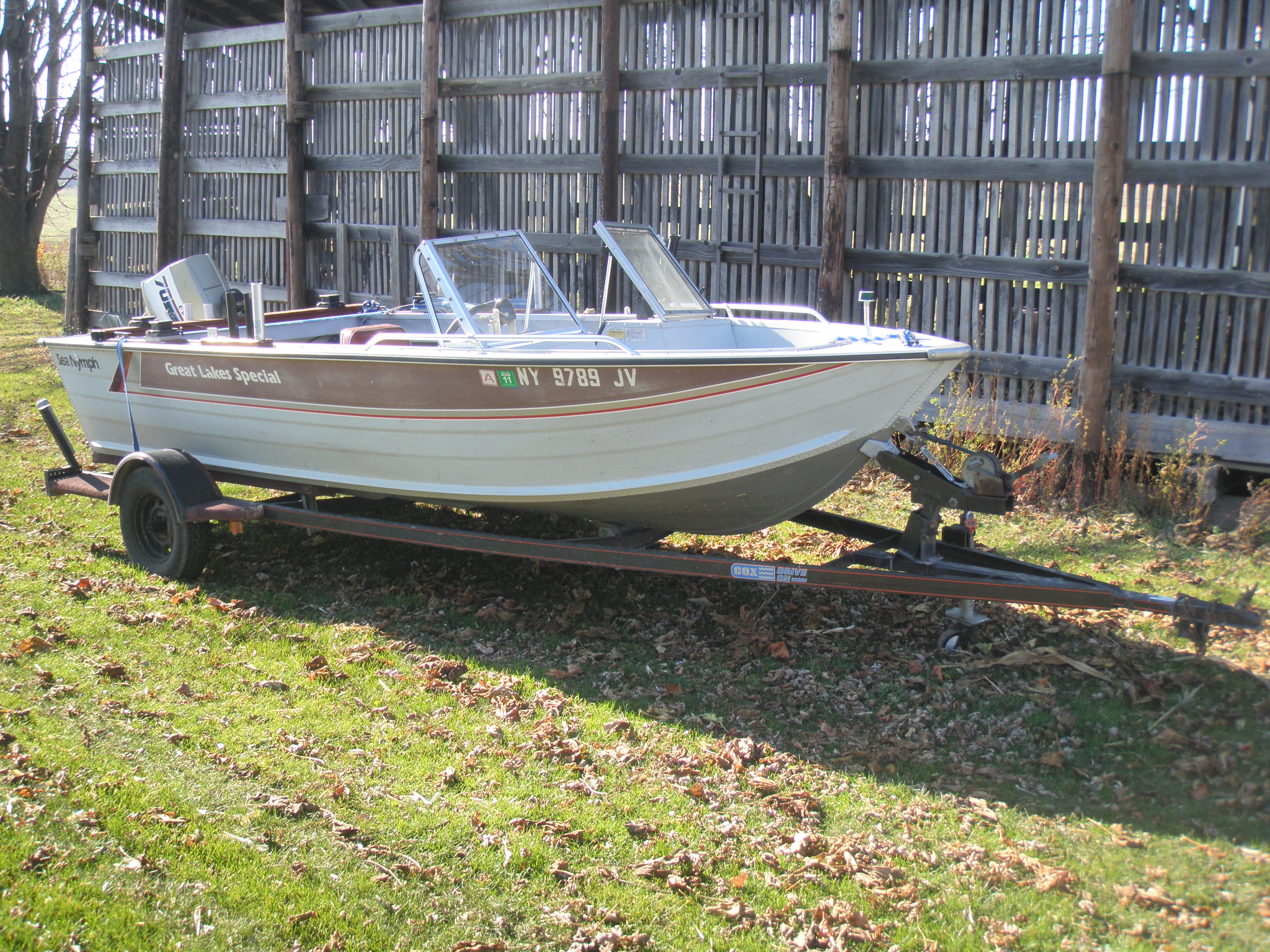|
Rhodes 18
The Rhodes 18 is an American trailerable day sailer or sailing dinghy that was designed by Philip Rhodes in 1938 and first built in 1948. It is Rhodes' design #448. Production The design has been built by Cape Cod Shipbuilding in the United States since 1948 and remains in production. Design The boat was designed as a junior trainer for the Stamford Yacht Club in Connecticut. The Rhodes 18 is a recreational sailboat, initially built from wood, since 1965 it has been constructed from fiberglass, with wood trim. The hull has decks all around the cockpit. It has a fractional sloop rig, a plumb stem, a vertical transom, a transom-hung rudder controlled by a tiller and a retractable centerboard or an optional fixed fin keel. The centerboard version displaces , while the keelboat model displaces . With no centerboard truck, the keel-equipped version provides more unobstructed cockpit space. The boat will hold five adults, but is normally sailed with a crew of two. ... [...More Info...] [...Related Items...] OR: [Wikipedia] [Google] [Baidu] |
Philip Rhodes
Philip Leonard Rhodes (1895–1974) was an American naval architect known for his diverse yacht designs. Life Rhodes designed a wide variety of vessels from 7' dinghies to 123' motor-sailors, from hydrofoil racers to America's Cup winners - his 12 Meter class '' Weatherly'' (USA-17) winning the 1962 defense. His work also included large motor yachts, commercial and military vessels such as minesweepers and police boats. His clients ranged from Rockefellers to Sears & Roebuck.Retrieved on 08-10-09 Rhodes was born in 1895 in Thurman, Ohio. He attended MIT, graduating in 1918 in naval architecture and marine engineering.Retrieved on 08-10-09 He worked for the US Army Corps of Engineers during World War I. After the war he began work as a shipfitter in Lorain, Ohio. He later moved to New York where he opened a small office as a marine architect. Rhodes joined the design firm of Cox & Stevens in 1934, becoming head naval architect there after the death of lead designer Bruno Tornrot ... [...More Info...] [...Related Items...] OR: [Wikipedia] [Google] [Baidu] |
Connecticut
Connecticut () is the southernmost state in the New England region of the Northeastern United States. It is bordered by Rhode Island to the east, Massachusetts to the north, New York to the west, and Long Island Sound to the south. Its capital is Hartford and its most populous city is Bridgeport. Historically the state is part of New England as well as the tri-state area with New York and New Jersey. The state is named for the Connecticut River which approximately bisects the state. The word "Connecticut" is derived from various anglicized spellings of "Quinnetuket”, a Mohegan-Pequot word for "long tidal river". Connecticut's first European settlers were Dutchmen who established a small, short-lived settlement called House of Hope in Hartford at the confluence of the Park and Connecticut Rivers. Half of Connecticut was initially claimed by the Dutch colony New Netherland, which included much of the land between the Connecticut and Delaware Rivers, although the first ... [...More Info...] [...Related Items...] OR: [Wikipedia] [Google] [Baidu] |
Boom Vang
A boom vang (US) or kicking strap (UK) (often shortened to "vang" or "kicker") is a line or piston system on a sailboat used to exert downward force on the Boom (sailing), boom and thus control the shape of the sail. The Collins English Dictionary defines it as "A rope or tackle extended from the boom of a fore-and-aft mainsail to a deck fitting of a vessel when running, in order to keep the boom from riding up". The vang typically runs from the base of the Mast (sailing), mast to the Boom (sailing), boom. Due to the great force necessary to change the height of the boom while a boat is under sail, a line-based boom vang usually includes some sort of a pulley system. Hydraulic piston vangs are used on larger sailboats and controlled by manual or electric hydraulic pumps. By controlling leech tension, the boom vang is one way of controlling sail twist. The boom vang may also be used to flatten the mainsail on dinghy, dinghies. On small sailboats and some cruising sailboats a va ... [...More Info...] [...Related Items...] OR: [Wikipedia] [Google] [Baidu] |
Roller Furling
Roller furling is a method of furling (i.e. reefing) a yacht's staysail by rolling the sail around a stay. Roller furling is typically used for foresails such as jibs or genoas. A mainsail may also be furled by a similar system, whereby the sail is furled within the mast or around a rotating boom (or around a rotating shaft within a boom). Although staysail roller-furling is effective and very common, in-mast or in-boom mainsail furling involves some compromises, and mainsail slab reefing gives a better sail shape. Methods The idea for a furling jib is usually attributed to Major E du Boulay in England who invented a device similar to a roller blind for reefing a jib. Major Wykeham-Martin used one of Boulay's rollers and improved the system by incorporating roller bearings in 1907 when the system was patented. The original castings were made by London-based toilet makers Bouldings. By the 1940s nearly every British cruising yacht was fitted with this furling system. An earl ... [...More Info...] [...Related Items...] OR: [Wikipedia] [Google] [Baidu] |
Hull Speed
Hull speed or displacement speed is the speed at which the wavelength of a vessel's bow wave is equal to the waterline length of the vessel. As boat speed increases from rest, the wavelength of the bow wave increases, and usually its crest-to-trough dimension (height) increases as well. When hull speed is exceeded, a vessel in displacement mode will appear to be climbing up the back of its bow wave. From a technical perspective, at hull speed the bow and stern waves interfere constructively, creating relatively large waves, and thus a relatively large value of wave drag. Ship drag for a displacement hull increases smoothly with speed as hull speed is approached and exceeded, often with no noticeable inflection at hull speed. The concept of hull speed is not used in modern naval architecture, where considerations of speed/length ratio or Froude number are considered more helpful. Background As a ship moves in the water, it creates standing waves that oppose its movement. T ... [...More Info...] [...Related Items...] OR: [Wikipedia] [Google] [Baidu] |
Spinnaker
A spinnaker is a sail designed specifically for sailing off the wind on courses between a reach (wind at 90° to the course) to downwind (course in the same direction as the wind). Spinnakers are constructed of lightweight fabric, usually nylon, and are often brightly colored. They may be designed to perform best as either a reaching or a running spinnaker, by the shaping of the panels and seams. They are attached at only three points and said to be ''flown''. Nomenclature Informal names for a spinnaker are ''kite'' or ''chute'' (owing to their resemblance to a parachute in both construction and appearance). Boats may have more than one spinnaker, differentiated by a letter to indicate symmetric (S) or asymmetric (A) and a number to indicate size (with higher numbers indicating smaller size), e.g. ''A1'' would be a large asymmetric sail and ''S3'' would be a smaller symmetric sail. Operation A spinnaker is used for sailing with the direction of the wind. Symmetrical ... [...More Info...] [...Related Items...] OR: [Wikipedia] [Google] [Baidu] |
Boat Trailer
A boat trailer is designed to launch, retrieve, carry and sometimes store boats. Commercial boat trailers Commercial hydraulic boat trailers are used by marinas, boat yards, boat haulers, boat dealers and boat builders. Generally this type of trailer is not used for storage of the boat. Self-propelled Self-propelled boat movers are not strictly trailers, but hydraulically operated boat movers, with their own tractor unit. They share all of the features of hydraulic boat trailers. Non-commercial boat trailers This type of trailer is usually used by the boat owner/operator. The trailer is also used for storage. * Roll-on, also known as a "Roller style trailer", uses rubber and/or polyurethane rollers for ease of launching and loading a boat. * Glide-path, also known as a "Float-on style trailer", allows the boat to float onto the trailer; after the trailer has been partially submerged (usually of the trailer). Since its inception, it has become quite popular compared to the ... [...More Info...] [...Related Items...] OR: [Wikipedia] [Google] [Baidu] |
Beaching (nautical)
Beaching (or Landing) is the process in which a ship or boat is laid ashore, or grounded deliberately in shallow water. This is more usual with small flat-bottomed boats. Larger ships may be beached deliberately; for instance, in an emergency, a damaged ship might be beached to prevent it from sinking in deep water. Some vessels are designed to be loaded and unloaded by beaching; vessels of this type used by the military to disembark troops under fire are called landing craft. During the age of sail, vessels were sometimes beached to allow them to be rolled over for the hull to be maintained, a process called '' careening''. Ships scheduled for break-up are sometimes intentionally beached to make the procedure easier. See also * Landing craft * Shipwrecking Shipwrecking is an event that causes a shipwreck, such as a ship striking something that causes the ship A ship is a large watercraft that travels the world's oceans and other sufficiently deep waterways, carryi ... [...More Info...] [...Related Items...] OR: [Wikipedia] [Google] [Baidu] |
Keelboat
A keelboat is a riverine cargo-capable working boat, or a small- to mid-sized recreational sailing yacht. The boats in the first category have shallow structural keels, and are nearly flat-bottomed and often used leeboards if forced in open water, while modern recreational keelboats have prominent fixed fin keels, and considerable draft. The two terms may draw from cognate words with different final meaning. A keep boat, keelboat, or keel-boat is a type of usually long, narrow cigar-shaped riverboat, or unsheltered water barge which is sometimes also called a poleboat—that is built about a slight keel and is designed as a boat built for the navigation of rivers, shallow lakes, and sometimes canals that were commonly used in America including use in great numbers by settlers making their way west in the century-plus of wide-open western American frontiers. They were also used extensively for transporting cargo to market, and for exploration and trading expeditions, for w ... [...More Info...] [...Related Items...] OR: [Wikipedia] [Google] [Baidu] |
Keel
The keel is the bottom-most longitudinal structural element on a vessel. On some sailboats, it may have a hydrodynamic and counterbalancing purpose, as well. As the laying down of the keel is the initial step in the construction of a ship, in British and American shipbuilding traditions the construction is dated from this event. Etymology The word "keel" comes from Old English , Old Norse , = "ship" or "keel". It has the distinction of being regarded by some scholars as the first word in the English language recorded in writing, having been recorded by Gildas in his 6th century Latin work '' De Excidio et Conquestu Britanniae'', under the spelling ''cyulae'' (he was referring to the three ships that the Saxons first arrived in). is the Latin word for "keel" and is the origin of the term careen (to clean a keel and the hull in general, often by rolling the ship on its side). An example of this use is Careening Cove, a suburb of Sydney, Australia, where careening was carried ... [...More Info...] [...Related Items...] OR: [Wikipedia] [Google] [Baidu] |
Tiller
A tiller or till is a lever used to steer a vehicle. The mechanism is primarily used in watercraft, where it is attached to an outboard motor, rudder post or stock to provide leverage in the form of torque for the helmsman to turn the rudder. A tiller may also be used in vehicles outside of water, and was seen in early automobiles. On vessels, a tiller can be used by the helmsman directly pulling or pushing it, but it may also be moved remotely using tiller lines or a ship's wheel. Rapid or excessive movement of the tiller results in an increase in drag and will result in braking or slowing the boat. Description A tiller is a lever used to steer a vehicle. It provides leverage in the form of torque to turn the device that changes the direction of the vehicle, such as a rudder on a watercraft or the surface wheels on a wheeled vehicle. A tiller can be used by directly pulling or pushing it, but it may also be moved remotely using tiller lines or a ship's wheel; some kay ... [...More Info...] [...Related Items...] OR: [Wikipedia] [Google] [Baidu] |
Transom (nautical)
A transom is the vertical reinforcement which strengthens the stern of a boat. This flat termination of the stern is typically above the waterline. The term was used as far back as Middle English in the 1300s, having come from Latin ''transversus'' (transverse) via Old French ''traversain'' (set crosswise). The stern of a boat is typically vertical. It can be raked such that there is an overhang above the water, as at the bow. A reverse transom is angled from the waterline forwards. Transoms can be used to support a rudder, outboard motor, or as a swimming and access platform. Gallery File:The Bermuda cedar (Juniperus bermudiana) transom of Spirit of Bermuda, 2016.jpg, The Bermuda cedar transom of the Spirit of Bermuda File:Sea Scooter transom.jpg, Flat transom on a dinghy with mount points for a rudder. File:Coble on shore at Boulmer (2) - geograph.org.uk - 1381157.jpg, Raked transom with rudder mount points. File:CS 30 Sailboat Kelsea 0297.jpg, Reverse transom with rudde ... [...More Info...] [...Related Items...] OR: [Wikipedia] [Google] [Baidu] |





